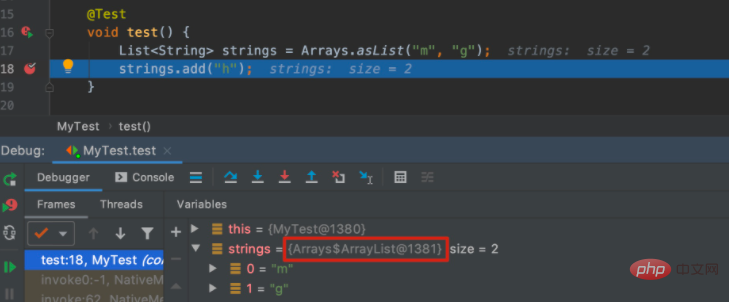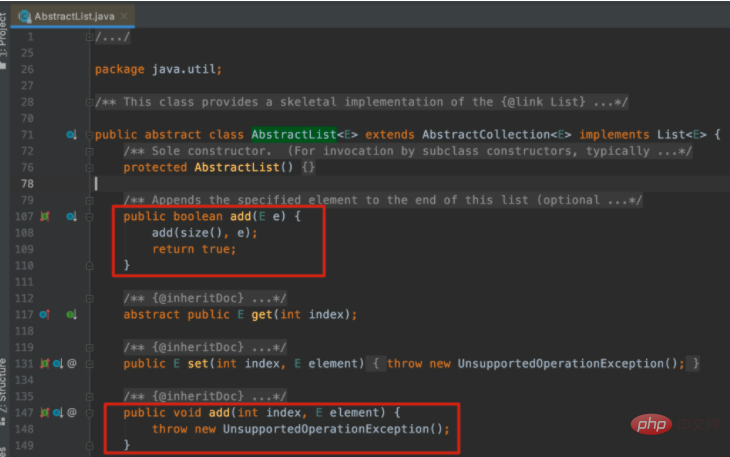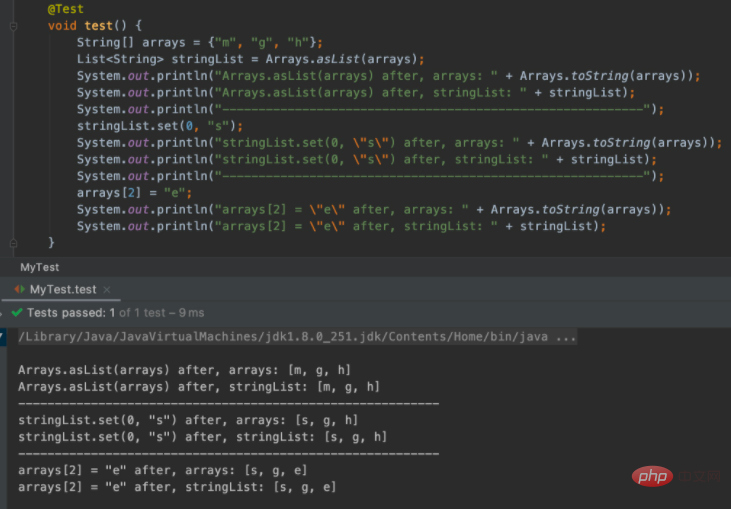Record the pitfalls of Java collection class List
Java basic tutorialColumn introduction Collection class includes two major categories: Map and Collection

Recommendation (free): java basic tutorial
Some high-level programming languages now provide the implementation of various out-of-the-box data structures, such as Java programming The collection framework of the language provides various implementations. The collection class includes two major categories: Map and Collection. The List below Collection is one of the collection classes we often use. Many business codes are inseparable from it. Today Let’s take a look at some pitfalls of List lists.
The first pitfall: the List returned by the Arrays.asList method does not support addition and deletion operations
For example, if we execute the following code:
List<String> strings = Arrays.asList("m", "g");
strings.add("h");will throwjava .lang.UnsupportedOperationException Exception, what is your OS at this time? Why can't elements be added to the returned ArrayList? Can elements be added properly in the future? , and then decisively enable Debug Dafa:

found that the returned ArrayList is not our commonly used java .util.ArrayList, but the inner class java.util.Arrays.ArrayList of Arrays. Enter the method Arrays.asList and the source code is as follows:
public static <T> List<T> asList(T... a) {
return new ArrayList<>(a);
}The method returns the static internal class java.util.Arrays.ArrayList of Arrays, Although this class and java.util.ArrayList also inherit from the abstract class java.util.AbstractList, but through the source code of this class, it is found that it does not have any reference to the abstract parent class AbstractList 's add method throws java.lang.UnsupportedOperationException exception by default.

The root cause of this pitfall is that the add method of the strings returned by our call is inherited from the abstract parent classadd method, and the method of the abstract parent class throws the java.lang.UnsupportedOperationException exception by default.
The second pitfall is that the new List returned by the Arrays.asList method and the modification of the original parameter group of the method will affect each other
Arrays.asList method except the aboveDoes not support adding or deleting elements In addition to this pit, there is another pit:

It can be found from the above code that modifications to the original array will affect The new List we obtained through the Arrays.asList method can be found by digging into the source code of java.util.Arrays.ArrayList:
private static class ArrayList<E> extends AbstractList<E>
implements RandomAccess, java.io.Serializable
{
private static final long serialVersionUID = -2764017481108945198L;
private final E[] a;
ArrayList(E[] array) {
a = Objects.requireNonNull(array);
}
...
} The original array is used directly, so we must pay special attention when we use the List obtained by Arrays.asList. Because the array is shared, some unexpected bugs may occur when modifying each other. . One of the standard actions is to use it as a parameter of the ArrayList constructor method to new a List (e.g. List<String> stringList = new ArrayList<>(Arrays.asList(arrays))) or pass Lists.newArrayList in the Guava library, the new List will be returned Decoupled from the original array, they will no longer affect each other.
The third pitfall is that if you directly traverse the List collection to delete elements, an error will be reported.
When you directly traverse the collection elements, adding or deleting elements will report an error. For example, if you execute the following code:
List<String> stringList = Lists.newArrayList("m", "g", "h");
for (String s : stringList) {
if (Arrays.asList("m", "h").contains(s)) {
stringList.remove(s);
}
} The above code can be compiled normally, but the java.util.ConcurrentModificationException exception will be thrown when executed. Looking at the source code, you can find that the deletion element method remove will modify the collection structure, and also That is, modCount (the number of actual modifications to the collection) will be modified. During the loop, the actual number of modifications to the current List collection modCount will be compared with the iterator modification. The number of expectedModCount, and expectedModCount is the modCount during initialization. If the two are not equal, a ConcurrentModificationException exception will be reported. There are two main solutions: 1. Use the iterator method of ArrayList to traverse, and then call the methods in it. 2. In JDK 1.8, you can use the removeIf method to perform deletion operations.
Finally, a heart-wrenching question: Call the remove method of ArrayList and pass in int basic type numbers and Integer Are the execution results of packaging type numbers the same?
The above is the detailed content of Record the pitfalls of Java collection class List. For more information, please follow other related articles on the PHP Chinese website!

Hot AI Tools

Undresser.AI Undress
AI-powered app for creating realistic nude photos

AI Clothes Remover
Online AI tool for removing clothes from photos.

Undress AI Tool
Undress images for free

Clothoff.io
AI clothes remover

Video Face Swap
Swap faces in any video effortlessly with our completely free AI face swap tool!

Hot Article

Hot Tools

Notepad++7.3.1
Easy-to-use and free code editor

SublimeText3 Chinese version
Chinese version, very easy to use

Zend Studio 13.0.1
Powerful PHP integrated development environment

Dreamweaver CS6
Visual web development tools

SublimeText3 Mac version
God-level code editing software (SublimeText3)

Hot Topics
 1386
1386
 52
52
 Perfect Number in Java
Aug 30, 2024 pm 04:28 PM
Perfect Number in Java
Aug 30, 2024 pm 04:28 PM
Guide to Perfect Number in Java. Here we discuss the Definition, How to check Perfect number in Java?, examples with code implementation.
 Weka in Java
Aug 30, 2024 pm 04:28 PM
Weka in Java
Aug 30, 2024 pm 04:28 PM
Guide to Weka in Java. Here we discuss the Introduction, how to use weka java, the type of platform, and advantages with examples.
 Smith Number in Java
Aug 30, 2024 pm 04:28 PM
Smith Number in Java
Aug 30, 2024 pm 04:28 PM
Guide to Smith Number in Java. Here we discuss the Definition, How to check smith number in Java? example with code implementation.
 Java Spring Interview Questions
Aug 30, 2024 pm 04:29 PM
Java Spring Interview Questions
Aug 30, 2024 pm 04:29 PM
In this article, we have kept the most asked Java Spring Interview Questions with their detailed answers. So that you can crack the interview.
 Break or return from Java 8 stream forEach?
Feb 07, 2025 pm 12:09 PM
Break or return from Java 8 stream forEach?
Feb 07, 2025 pm 12:09 PM
Java 8 introduces the Stream API, providing a powerful and expressive way to process data collections. However, a common question when using Stream is: How to break or return from a forEach operation? Traditional loops allow for early interruption or return, but Stream's forEach method does not directly support this method. This article will explain the reasons and explore alternative methods for implementing premature termination in Stream processing systems. Further reading: Java Stream API improvements Understand Stream forEach The forEach method is a terminal operation that performs one operation on each element in the Stream. Its design intention is
 TimeStamp to Date in Java
Aug 30, 2024 pm 04:28 PM
TimeStamp to Date in Java
Aug 30, 2024 pm 04:28 PM
Guide to TimeStamp to Date in Java. Here we also discuss the introduction and how to convert timestamp to date in java along with examples.
 Java Program to Find the Volume of Capsule
Feb 07, 2025 am 11:37 AM
Java Program to Find the Volume of Capsule
Feb 07, 2025 am 11:37 AM
Capsules are three-dimensional geometric figures, composed of a cylinder and a hemisphere at both ends. The volume of the capsule can be calculated by adding the volume of the cylinder and the volume of the hemisphere at both ends. This tutorial will discuss how to calculate the volume of a given capsule in Java using different methods. Capsule volume formula The formula for capsule volume is as follows: Capsule volume = Cylindrical volume Volume Two hemisphere volume in, r: The radius of the hemisphere. h: The height of the cylinder (excluding the hemisphere). Example 1 enter Radius = 5 units Height = 10 units Output Volume = 1570.8 cubic units explain Calculate volume using formula: Volume = π × r2 × h (4
 Create the Future: Java Programming for Absolute Beginners
Oct 13, 2024 pm 01:32 PM
Create the Future: Java Programming for Absolute Beginners
Oct 13, 2024 pm 01:32 PM
Java is a popular programming language that can be learned by both beginners and experienced developers. This tutorial starts with basic concepts and progresses through advanced topics. After installing the Java Development Kit, you can practice programming by creating a simple "Hello, World!" program. After you understand the code, use the command prompt to compile and run the program, and "Hello, World!" will be output on the console. Learning Java starts your programming journey, and as your mastery deepens, you can create more complex applications.




